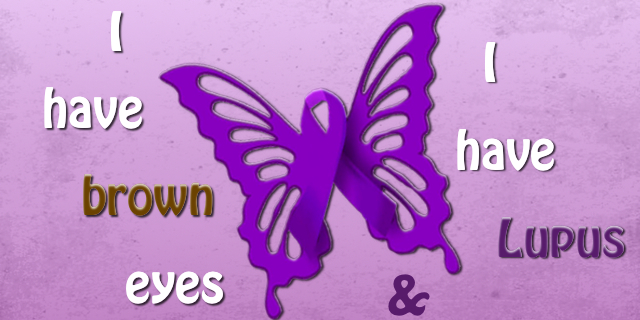What’s Wrong With Me?
“The therapist thought a ‘nose job’ would improve my self-esteem,” Amanda Greene remembers. He could never have guessed that the suggestion of surgery would finally result in a diagnosis of the cluster of strange symptoms that she was experiencing.  At 15, Amanda bruised easily and was constantly tired. “After school, I needed to nap before I did my homework. While many of my friends had jobs, I took naps.” The doctors couldn’t find anything wrong, “I failed over 10 mono tests,” she recounts. Thinking Amanda was just making up her symptoms, her physician sent her to group therapy. “The therapist said I’d be prettier with a ‘new nose’.” Only when lab work (ordered in preparation for the surgery) returned at abnormal levels, did her healthcare team investigate further. Even then, “it took another 4 months to figure out that I had lupus.” For Amanda, “the diagnosis was a relief. My stepbrothers had been calling me a hypochondriac. I was glad to know that ‘it was not in my head.’”
At 15, Amanda bruised easily and was constantly tired. “After school, I needed to nap before I did my homework. While many of my friends had jobs, I took naps.” The doctors couldn’t find anything wrong, “I failed over 10 mono tests,” she recounts. Thinking Amanda was just making up her symptoms, her physician sent her to group therapy. “The therapist said I’d be prettier with a ‘new nose’.” Only when lab work (ordered in preparation for the surgery) returned at abnormal levels, did her healthcare team investigate further. Even then, “it took another 4 months to figure out that I had lupus.” For Amanda, “the diagnosis was a relief. My stepbrothers had been calling me a hypochondriac. I was glad to know that ‘it was not in my head.’”
Life with Lupus
Amanda’s been on her “lupus journey” for 33 years now. During that time, she required extra time to complete her college education, “I was on the 6-year college plan” enduring a few professors “who thought I looked fine so ‘how could I be so sick?’” Lupus also impacts her ability to make a living. “Due to lupus, I work from home part-time. I’m unable to work a traditional 40-hour a week job.” However she has been able to incorporate one of her healthy coping mechanisms into her work. She is one of the creators of the web site and social network, POPULOVE.net. Its mission is to share “what fans can accomplish through music.” “Music is a big part of my warrior tool kit as it helps me deal and cope with pain, as well as assists me in shifting emotions and moods.”
What Is Lupus?
In lupus, like other autoimmune disorders, the body’s immune system cannot discriminate between foreign particles–bacteria and viruses–and its own healthy tissues. The immune system creates antibodies to attack healthy tissues, causing inflammation and pain as well as damage to skin, joints and a variety of organs. “My symptoms vary from acute chronic pain and inflammation to skin rashes, mouth sores and gastrointestinal distress,” Amanda relates. She also suffers from “painsomnia” a condition in which the severity of pain impairs sleep. Lupus is predominantly an illness of women; in fact, nine out of ten lupus patients are women. Most are diagnosed between the ages of 15 and 45. Women of color are two to three times more likely to be diagnosed than Caucasians. Yet men and people of all ethnicities can get lupus. The causes of lupus are both genetic and environmental. Lupus runs in families and siblings have a 20 times more likely to get lupus than the rest of the population. Environmental factors include exposure to the Epstein Barr virus (that causes mononucleosis), herpes zoster virus (which causes shingles) and the cytomegalovirus (which weakens the immune system).
“Smiles are contagious. Lupus is not.”
Lupus is a serious, though non-contagious condition. Diagnosis involves having four or more of the following symptoms:
- a butterfly-shaped rash across the cheeks and nose (malar rash)
- sun and light sensitivity (photosensitivity)
- oral or nasal ulcers; arthritis of multiple joints
- chest pain when breathing deeply (caused by inflammation of the lining of the heart or lungs)
- kidney disease
- neurological disorders, seizures and psychosis
- blood disorders such as a decrease in the number of red (anemia) and/or white blood cells (leukopenia, and lymphopenia.)
A blood test that narrows down the diagnosis is called the ANA (for antinuclear antibodies) test. If you have a negative ANA test, lupus is more likely to be ruled out as a diagnosis. In addition to the above symptoms, other common symptoms of lupus are fatigue, fever, painful joints, hair loss and headaches. Periods of remission and symptom flares are part of life with lupus. Moreover, people with lupus are at higher risk than the general population for lymphoma, breast, lung, cervical and endometrial cancer. The lupus advocacy symbol is a butterfly, which is the shape of one symptom of lupus, a butterfly-shaped rash across the cheeks and nose.
Learning to Cope
 Over 16,000 new cases of lupus are reported each year in the US. Coping with chronic ‘but you don’t look sick’ conditions can be challenging. “Learning about Lupus is a great idea but often the ‘medical jargon’ and information available can be overwhelming. Finding online and local support groups can be a critical part of learning to live with Lupus,” Amanda believes. To that end, she has found LupusChick.com to be a valuable website. She also belongs to several Facebook groups and is co-moderator (@lalupuslady) of a Twitter Chat called #LupusChat that meets bi-monthly on Sundays at 3pm ET. “I have discovered that a positive attitude helps me. I strive to find the flair of living with Lupus and “fighting (or avoiding) the flare” – switching it up and shifting my perspective helps me cope with the chronic issue on a daily basis.” “I am not defined by Lupus, but Lupus is a part of who I am. I have brown eyes and I have Lupus.”
Over 16,000 new cases of lupus are reported each year in the US. Coping with chronic ‘but you don’t look sick’ conditions can be challenging. “Learning about Lupus is a great idea but often the ‘medical jargon’ and information available can be overwhelming. Finding online and local support groups can be a critical part of learning to live with Lupus,” Amanda believes. To that end, she has found LupusChick.com to be a valuable website. She also belongs to several Facebook groups and is co-moderator (@lalupuslady) of a Twitter Chat called #LupusChat that meets bi-monthly on Sundays at 3pm ET. “I have discovered that a positive attitude helps me. I strive to find the flair of living with Lupus and “fighting (or avoiding) the flare” – switching it up and shifting my perspective helps me cope with the chronic issue on a daily basis.” “I am not defined by Lupus, but Lupus is a part of who I am. I have brown eyes and I have Lupus.”






I have hazel eyes and I have lupus.
Just a heads up on one thing, I am one of the rare group of people who have been diagnosed with lupus but have a negative ANA. It is possible although some will argue that point. For years, I had all the symptoms, the very high sed rates and extreme fatigue but was told it was just some kind of connective tissue disease. Later, a kind and knowledgable internist diagnosed me and I was later diagnosed with sjogrens syndrome, another auto-immune disease. Also I have the herpes zoster virus (which causes shingles because I’ve had shingles twice) and the cytomegalovirus (which weakens the immune system). All the obvious symptoms were there, but because I was ANA negative, I was not diagnosed as early as I should have been.
Thank you for sharing the fact that one’s ANA can be negative, yet Lupus can still be present.
I also have a lupus diagnosis and have 15 plus negative Ana. The specialists I saw told me that it is on average at least 7-10 negative Ana tests before a patient gets a positive, and that it should never be a one shot rules out lupus as a diagnosis. Sadly I suffered undiagnosed for ten years and developed a heroin habit because they saw my negative Anas and told me I was fine, and cut off my pain meds.
So if you get a negative, don’t let them tell you it is foolproof. It isn’t.
In my earlier comment, I forgot to mention that while I was waiting and hoping for some kind of diagnosis, I also suffered with many, many mouth sores which neither doctor nor dentist had an explanation for, I started getting arthritis in my spine which escalated over the years to include spinal stenosis, and later included my ankles, knees, shoulders, neck and now my hands and wrists. I have muscle pain, nerve pain, protein in my urine and now fibrosis in my lungs from the sjogrens. Auto-immune diseases are devastating, and sadly, most of us don’t really look as sick as we are, which is sad and I feel causes people to doubt the validity of our complaints or problems. For that reason, I always respond that I’m doing great and feel good. I don’t think most folks are truly interested in how we really feel. I’m 64 years old now and am still dealing with the effects of the lupus and sjogrens because it never leaves us. I am also experiencing breaks and cracks in my bones — SEVEN in the past two years from taking prednisone to help control the lupus and because my kidneys cannot take any inflammatories of any kind. Lupus can be controlled, but that is not always a given as we experience “flares” along the way. I wish everyone with lupus or any other auto-immune disease the very, very best. God Bless you.
Thank you so much for your comment! It is important for people to know the true extent of autoimmune diseases.
I am one who suffered a long time too before being diagnosed nothing going was conclusive test results never fell in compliance with the doctor’s reasoning yet symptoms and outward appearances were real and then everything would look like there was nothing wrong,therefore making it difficult for people to believe you I fought that place for a long time along with major depression and working as long as I could and then had a 5 year battle for disability to be given to me. But nevertheless I wanted to encourage someone else and though our stories are similar yet we are all on different paths of life experiences. For me I have found peace and solace in positivity and what I believe to be a relationship with God,that has caused a courage in me to rise above what mere man test,research and medicines say. For I have taken control of my life through my eating habits stopped all of their medications found out foods where the culprit and the preparation of how manufacturers have changed them from their original state with it being more chemicals than actual food. I no longer take any prescription medications, but found out about alleges of food. I am gluten free, no beef,pork or red meat some chicken and turkey limited, no peanuts,dairy milk or products,no soy,only raw sugar majority fruits and vegetables so I have to read all labels because I am allergic to these things. Man said there is no cure but I feel I have defied his logic with getting back to the basics. I lost all the weight from wrong eating and medication, no longer hurt as I use to, no swelling,have awesome flexibility and just plain freedom from the prison of what I call the lupus days. Learning to eat this way and staying the course is a challenge but very rewarding for my efforts. So to you who are suffering my prayers go out and up for your journey in that you find your place of freedom and that you not only conquer but overcome this disease that has no right in your life!!! Much love to you all from one who knows the battle!!!!!
Thank you for sharing your story. Kathleen
I have a positive ANA but am told it is no specific. I have had severe mouth and nose ulcers off and on since childhood. I have the classic butterfly rash and raynauds syndrome. Also, have had inflammation of the lining of the heart and lungs on different occasions. I’ve been going through severe fatigue, mild fevers and skin rashes for years. I am also anemic and experience severe headaches frequently. I still do not have a diagnosis of any sort. I just keep getting told that my symptoms are nonspecific. It is so frustrating. I see a rheumatologist every 3 months, but havent been put on any medications. The struggle is real.
33 years with Lupus? Well, One should consider treatment as Stem Cell therapy has a successful record for helping individuals to live a life without problems Lupus causes.
I have a feeling I may have Lupus. Is there a doctor in the Los Angeles city area who can run tests? I appreciate any suggestions, thanks.